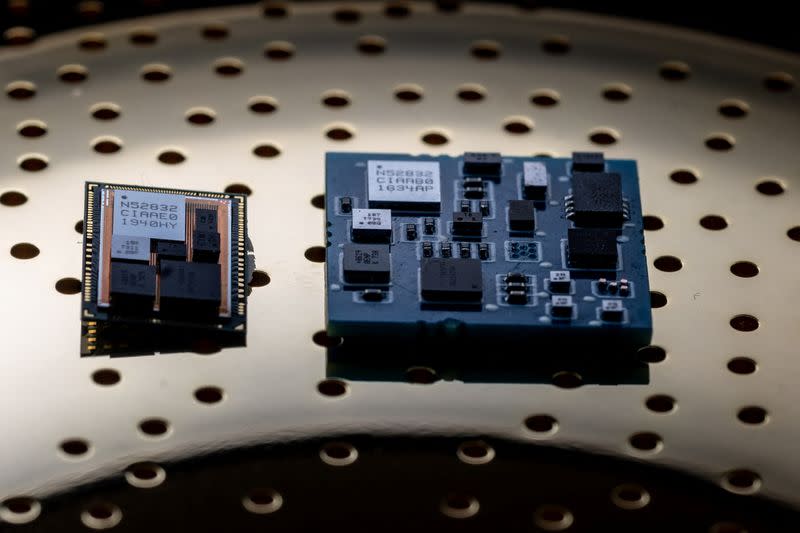Patents for ‘chiplets’ – small computer chips – developed by a struggling Silicon Valley company in the United States, were sold to China in 2021.
But questions about how this happened, and whether the Committee on Foreign Investment in the United States (CFIUS), could, or should, have done more to retain ownership of this technology, are now being asked because chipset technology is booming in China.
The sale of startup zGlue’s patents in 2021 was unremarkable except for the technology it owned, designed to cut the time and cost for making chips, showed up 13 months later in the patent portfolio of Chipuller, a startup in China’s southern tech hub Shenzhen.
Chipuller purchased chiplet technology, which is a cost efficient way to package groups of small semiconductors to form one powerful brain capable of powering everything from data centres to gadgets at home.
ALSO SEE:
Taiwan’s Foxconn Pulls Out of $19bn Vedanta India Chip JV
Chiplet tech has become more important
The previously unreported technology transfer coincides with a push for chiplet technology in China that started about two years ago, according to an analysis of hundreds of patents in the US and China and dozens of Chinese government procurement documents, research papers and grants, local and central government policy documents and interviews with Chinese chip executives.
Industry experts say chiplet technology has become even more important to China since the US barred it from accessing advanced machines and materials needed to make today’s most cutting edge chips, and now largely underpins the country’s plans for self-reliance in semiconductor manufacturing.
“US-China competition is on the same starting line,” Chipuller chairman Yang Meng said about chiplet technology in an interview. “In other (chip technologies) there is a sizeable gap between China and the United States, Japan, South Korea, Taiwan.”
Barely mentioned before 2021, Chinese authorities have highlighted chiplets more frequently in recent years, according to a review. At least 20 policy documents from local to central governments referred to it as part of a broader strategy to increase China’s capabilities in “key and cutting-edge technologies”.
“Chiplets have a very special meaning for China given the restrictions on wafer fabrication equipment,” Charles Shi, a chip analyst for brokerage Needham, said.
“They can still develop 3D stacking or other chiplet technology to work around those restrictions. That’s the grand strategy, and I think it might even work.”
Multiple uses seen for chiplet tech
Beijing is rapidly exploiting chiplet technology in applications as diverse as artificial intelligence to self-driving cars, with entities from tech giant Huawei Technologies to military institutions exploring its use.
More major investments in the area are on the way, according to a review of corporate announcements.
Chiplets, or small chips, can be the size of a grain of sand or bigger than a thumbnail and are brought together in a process called advanced packaging.
It is a technology the global chip industry has increasingly embraced in recent years as chip manufacturing costs soar in the race to make transistors so small they are now measured in the number of atoms.
Bonding chiplets tightly together can help make more powerful systems without shrinking the transistor size as the multiple chips can work like one brain.
Apple’s high-end computer lines use chiplet technology, as do Intel and AMD’s more powerful chips.
About a quarter of the global chip packaging and testing market sits in China, according to Dongguan Securities.
While some say this gives China an advantage in leveraging chiplet technology, Chipuller chairman Yang cautioned that the proportion of China’s packaging industry that could be considered advanced was “not very big”.
Under the right conditions, chiplets that are personalised according to the needs of the customer can be completed quickly, in “three to four months, this is the unique advantage China holds,” Yang said.
China ramps purchasing of chip packaging
Needham’s Shi said according to import data published by China’s customs agency, China’s purchase of chip packaging equipment soared to $3.3 billion in 2021 from its previous high of $1.7 billion in 2018, although last year it fell to $2.3 billion with the chip market downturn.
Since early 2021 research papers on chiplets started surfacing by researchers of the Chinese military People’s Liberation Army and universities it runs, and state-run and PLA-affiliated laboratories are looking to use chips made using domestic chiplet technology according to six tenders published over the past three years.
Public documents by the government also show millions of dollars worth of grants to researchers specializing in chiplet technology, while dozens of smaller companies have sprouted throughout China in recent years to meet domestic demand for advanced packaging solutions like chiplets.
‘zGlue case highlights need to reform CFIUS’
Against the backdrop of escalating US-China tension, Chinese company Chipuller acquired 28 patents either owned by zGlue or invented by people whose names are on zGlue’s patents, according to an analysis using IP management technology firm Anaqua‘s Acclaim IP database.
The acquisition was through a two-step transfer, first through British Virgin Islands-registered North Sea Investment Co Ltd, according to documents seen by Reuters and confirmed by Yang.
The Committee on Foreign Investment in the United States (CFIUS), a powerful Treasury-led committee that reviews transactions for potential threats to US security, did not respond to a request for comment about whether such sales would require their approval.
CFIUS lawyers Laura Black at Akin’s Trade Group, Melissa Mannino at BakerHostetler and Perry Bechky at Berliner Corcoran & Rowe say patent sales alone would not necessarily give CFIUS authority over the deal, as it depends whether the assets purchased constitute a US business.
Representative Mike Gallagher, an influential lawmaker whose select committee on China has pressed the Biden administration to take tougher stances on China, said zGlue’s case highlights the “urgent need to reform CFIUS”.
“(People’s Republic of China) entities should not be able to act with impunity to take advantage of distressed US firms to transfer their IP to China,” he said in an emailed statement.
Chipuller’s Yang said zGlue’s lawyer communicated with both CFIUS and the Department of Commerce to ensure the sale to North Sea would not fall foul of export controls.
But these discussions did not include mention of Chipuller or the possibility of a Chinese entity ending up in possession of the patents, according to a Chipuller spokesperson.
“Everything was done very transparently and in accordance with (US) law,” Yang said.
Yang said he considered himself a founder of zGlue as he became an investor in the company in 2015, soon after its formation, and later became a director and chairman.
CFIUS visited zGlue offices in 2018 to conduct an investigation because the company’s largest non-US investor, Yang, was from China, the chairman said.
“So we have spent a lot of time communicating with CFIUS,” Yang said, adding that Chipuller currently does not supply any Chinese military or US-sanctioned entities.
Chipuller isn’t the only firm with chiplet technology.
Huawei files 900 chiplet-linked patent, grant applications
Huawei, China’s tech and chip design giant that has been put on the US’s most restricted list, has been actively filing chiplet patents.
Huawei published over 900 chiplet-related patent applications and grants last year in China, up from 30 in 2017, according to Anaqua’s director of analytics solutions Shayne Phillips.
Huawei declined to comment.
Over the past two years, there were over a dozen announcements for new factories or expansions of existing ones from companies using chiplet technology in manufacturing across China’s tech sector, representing an investment totalling over 40 billion yuan.
They include domestic giants TongFu Microelectronics and JCET Group, as well as fast-growing startups such as Beijing ESWIN Technology Group, which spent 5.5 billion yuan on a factory for its chiplet-focused subsidiary that began operating in April.
One article published in May by an outlet run by China’s Ministry of Industry and Information Technology (MIIT) urged big Chinese tech firms to use domestic packaging companies such as TongFu to help build China’s self-sufficiency in computing power.
“Use Chiplet technology to break through the United States’ siege of my country’s advanced process chips,” it said.
MIIT did not respond to a request for comment.
Chipuller chairman Yang puts it this way: “Chiplet technology is the core driving force for the development of the domestic semiconductor industry,” he said on the company’s official WeChat channel.
“It is our mission and duty to bring it back to China.”
- Reuters with additional editing by Jim Pollard
ALSO SEE:
Curbs on Chipmaking Metals ‘Just The Beginning’, China Warns
US to Cut China Access to Amazon, Microsoft Cloud Computing: WSJ
China Curbs Mean Permanent Loss of Opportunities for US, Nvidia Says
US to Target Investment in China Chips, AI, Quantum Computing
EU to Beef Up Japan Ties on Chips, AI to ‘De-Risk’ From China
Chipmakers Shares Drop on Report of New US Chip Bans to China
























